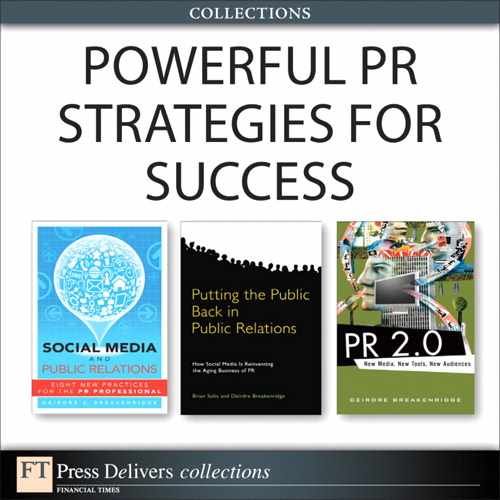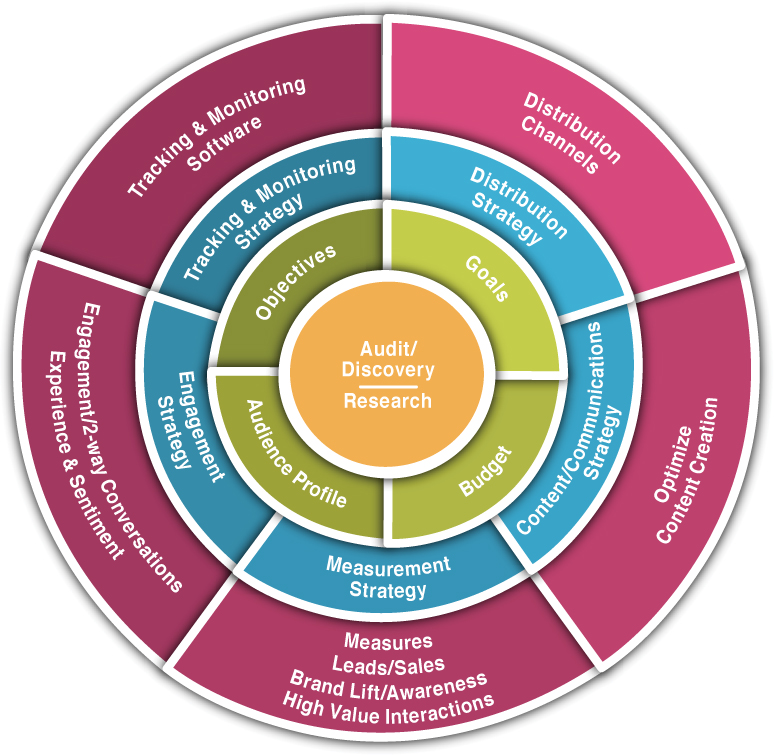A. The Social Media Strategy Wheel
I developed and introduced the Social Media Strategy Wheel in 2009. It’s been updated in this book to help PR and communications professionals visualize the core components of social media strategy and planning. To effectively use the wheel, you must work from the inside circle out. With any communications program, you begin with the audit/discovery and research phase to evaluate resources and techniques that work in earlier initiatives. The information you uncover during the discovery phase can help you to create a stronger program, with goals and objectives, appropriate target audiences, and the budgetary requirements necessary to launch your effort.
The main sections of the wheel (Tracking & Monitoring, Channel/Distribution, Communications/Content, Engagement, and Measurement) are the areas to help you formalize your strategies and tactics to successfully reach your goals. It’s critical to realize that all strategies and tactics must map back to your overall objectives. Social media requires you to think differently about your planning and strategy because you are joining communications with technology and always keeping in mind the behavioral preferences of your target audiences.
Following are the questions you must ask for each major area of strategy development represented on the wheel:
• Tracking & Monitoring Strategy: What are the key topics and relevant information important to my audience? Setting up a monitoring and tracking strategy enables you to uncover a better approach to storytelling and participating with groups in social media communities.
• Distribution/Channel Strategy: Where does my audience participate—on what kinds of networks and what platforms? Understanding the way groups participate, collaborate, and share in particular social communities can help you to create a channel and distribution strategy for greater opportunities to engage.
A.1. The Social Media Strategy Wheel
• Communications/Content Optimization Strategy: What are the critical issues of the influencers and brand advocates? What content excites them and how do they like to share content (in what formats)? A communications and content strategy helps you to develop and optimize your content and messaging for maximum impact.
• Engagement Strategy: What are the best ways to engage with an audience or what actions do you want them to take? Do you want them to learn about the brand, provide endorsements, create their own content, share your information, or develop a mutually reciprocal or strategic relationship? When you determine your engagement strategy, you can see clearly how certain types of engagement lead to higher-level adoption and business outcomes versus lower-level participation in communities.
• Measurement Strategy: What measurement strategy needs to be put in place to track/benchmark program success? What are the metrics that map back to higher-level goals and objectives? The measurement strategy enables you to show the value of the PR/Social Media program by tracking metrics that reveal leads, sales, registrations, learning, strategic relationships, reputation management, and thought leadership.
The Social Media Strategy Wheel houses all the critical components of your social media plan. You must develop your strategies first, by going through each section of the wheel, before you roll out with communications tactics to reach target audiences through the various social media channels.

